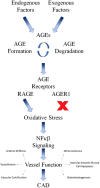The role of advanced glycation end-products in the development of coronary artery disease in patients with and without diabetes mellitus: a review
- PMID: 30470170
- PMCID: PMC6251169
- DOI: 10.1186/s10020-018-0060-3
The role of advanced glycation end-products in the development of coronary artery disease in patients with and without diabetes mellitus: a review
Abstract
Background: Traditional risk factors are insufficient to explain all cases of coronary artery disease (CAD) in patients with diabetes mellitus (DM). Advanced glycation end-products (AGEs) and their receptors may play important roles in the development and progression of CAD. BODY: Hyperglycemia is the hallmark feature of DM. An increase in the incidence of both micro-and macrovascular complications of diabetes has been observed with increased duration of hyperglycemia. This association persists even after glycemic control has been achieved, suggesting an innate mechanism of "metabolic memory." AGEs are glycated proteins that may serve as mediators of metabolic memory due to their increased production in the setting of hyperglycemia and generally slow turnover. Elevated AGE levels can lead to abnormal cross linking of extracellular and intracellular proteins disrupting their normal structure and function. Furthermore, activation of AGE receptors can induce complex signaling pathways leading to increased inflammation, oxidative stress, enhanced calcium deposition, and increased vascular smooth muscle apoptosis, contributing to the development of atherosclerosis. Through these mechanisms, AGEs may be important mediators of the development of CAD. However, clinical studies regarding the role of AGEs and their receptors in advancing CAD are limited, with contradictory results.
Conclusion: AGEs and their receptors may be useful biomarkers for the presence and severity of CAD. Further studies are needed to evaluate the utility of circulating and tissue AGE levels in identifying asymptomatic patients at risk for CAD or to identify patients who may benefit from invasive intervention.
Keywords: Advanced glycation end-products (AGEs); Coronary artery disease (CAD); Diabetes mellitus (DM); Receptor for advanced glycation end-products (RAGE).
Conflict of interest statement
Ethics approval and consent to participate
Not applicable
Consent for publication
Not applicable
Competing interests
The authors declare that they have no competing interests.
Publisher’s Note
Springer Nature remains neutral with regard to jurisdictional claims in published maps and institutional affiliations.
Figures


References
Publication types
MeSH terms
Substances
LinkOut - more resources
Full Text Sources
Other Literature Sources
Medical
Molecular Biology Databases
Miscellaneous

